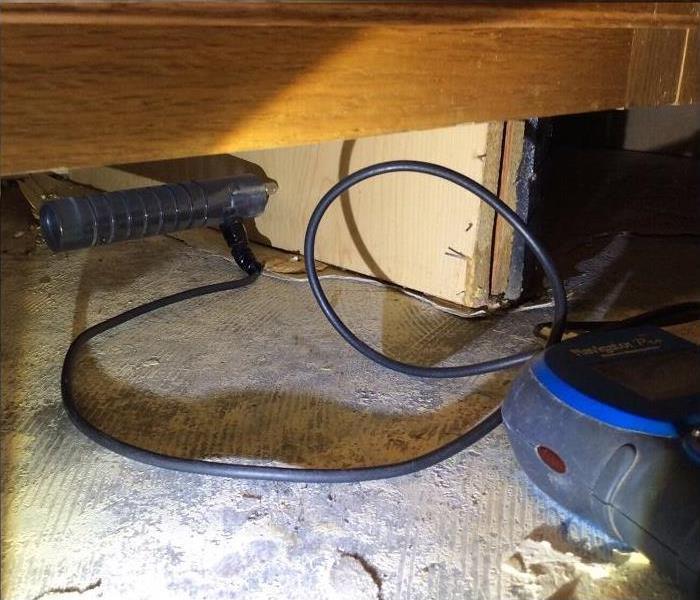Six Possible Signs of Water Damage
6/10/2019 (Permalink)
Finding Water damage isn’t always as obvious as walking into a room flooded with six inches of water. Sometimes picking up on the signs of water damage is a little more difficult than that. A slight musty smell could be an indicator that moisture is intruding into your home or business.
If you have questions about water damage give SERVPRO of Bartow County a call. We can schedule a convenient time to inspect your property.
This is a list of possible causes and signs of water damage. Take a moment to review them to better understand the possible signs of water damage and how water damage sometimes happens.
- Drainage Issues- A major contributing factor to most water loss caused by outside water coming in is the structures drainage. It can also be one of the most expensive to fix, and is not always obvious to home or business owners at first glance. Most drainage issues become apparent after a large rainstorm, but oftentimes this is too late to prevent water damages.
- Foundation Faults or Cracks - The foundation of a building provides structure and stabilization for the entire building. Issues with the foundation can cause some nasty problems including water damage. You should inspect your foundation periodically to insure you have not developed any cracks, existing cracks have not expanded, or see any crumbling portions of the foundation. Often times damage to a foundation is due to the house “settling” into the ground. Water damage stemming from foundational issues can be very complicated and are best handled by trained professionals like SERVPRO of Bartow County,
- Signs of Leaks - This is probably one of the easiest types of water damage to spot. Signs include paint or wallpaper bubbling, staining and discoloration of walls, ceilings or carpets. Ceilings that appear to be sagging could be a result of water damage and can be hazardous due to the likely-hood of falling sheetrock. Leaks like these are typically slow moving and develop over time. They can also be signs of other issues like an aging roof, permeable masonry or brickwork, plumbing in need of repair, and faulty rain gutters, just to name a few.
- Sewer Line Issues - Sewer backups or overflows are probably one of the hardest types of water damage to prevent because you have little control over the public sewer systems. However, home and business owners are typically responsible for maintaining the pipes and drains that lead from their property to the road or sewer system. Short of calling a professional and having them “scope” your sewer lines, send a small camera on a retractable line down drain pipes and lines. There is no way of knowing what lies in your sewer lines. A possible indicator of “back-up sewer lines” would be slow draining fixtures like showers and sinks.
- Flickering Electricity - Flickering lights and humming switches, particularly in older homes or buildings, could be a sign of water intrusion. They can also be fire hazards, so it is important to have trained professionals inspect any electrical circuits that are behaving irregularly.
- Mold - Mold, mildew, dry rot, and fungus can all be a result of water damage. Often times you will find these types of growth in areas that have experienced “slow moving” water damage. Meaning that the water damage and growth developed over an extended amount of time. Even small amounts of moisture under the right conditions can foster millions of mold spores and fungus. For more information about mold check out our previous blog Ten Things You Should Know About Mold.
Classification of Contaminated Water
- Category One (CAT1) is the least harmful. Thought of as clean water, or water that doesn’t pose health concerns or threats to humans. This damage affects only part of a room, with materials that include particle board, plywood, structural wood, vinyl composition tile, and concrete. Often caused by broken or leaking appliances or sinks.
- Category Two (CAT2) is often referred to as greywater and may cause sickness if ingested due to microorganisms. Has a fast rate of evaporation. This faster rate means that carpets and cushions are damaged. The seepage of water up a wall is less than 24 inches, and moisture is held within structural materials. Often caused by broken toilets, sump pumps, and HVAC drainage lines.
- Category Three (CAT3) is commonly known as “blackwater” and is unsanitary due to bacteria and other organisms that can cause sickness and other health issues. Has the fastest rate of evaporation. Damage may come from faulty sprinklers or other ceiling sources that can soak the walls, furniture, carpets, ceilings and the subfloor. A wide-spread water event.
- Category Four (CAT4) requires special water restoration and removal treatment. This classification affects flooring, plaster, stone, brick, crawlspaces, and concrete.
SERVPRO of Bartow County can help if you have water damage! Give us a call today (770) 387-7455!
Like us on Facebook or leave us a Google Review!






 24/7 Emergency Service
24/7 Emergency Service
